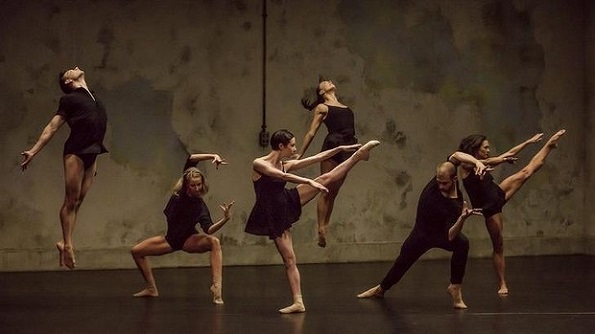Sydney Theatre
March 9, 2015
By Elizabeth Ashley of Dance Informa.
Sydney Dance Company’s latest program, Frame of Mind, offers a myriad of contrasts for the audience to reflect upon. The initial spark of inspiration was Artistic Director Rafael Bonachela’s experience of “wanting to be in two places at once.” He stated, “Both places were equally important to me.” The two works presented are as contrasting as night and day, leaving the audience with a sense of dance as complex possibilities.
This program also provides Australian audiences with the opportunity to experience the very personal and highly acclaimed Quintett by William Forsythe alongside Rafael Bonachela’s brand-new Frame of Mind.
The program opens with William Forsythe’s Quintett. What is striking about this work is it’s simplicity, with no attempt to transcend the every day. What is unexpected is the breathtaking beauty of the choreography with its swirling shapes as five dancers present dance which is colourful, bright and quite Arcadian, as if performed at the peak of a summer’s day. Forsythe’s choreography quotes and celebrates ballet’s fundamentals whilst being neither stark nor repetitious.
This celebration of the everyday could easily create a clichéd dance language. However, this is avoided by the total engagement of the dancers and their intuitive sensitivity to the everyday with all its implied minutiae, which they embody and capture superbly. Quintett is a very human work, with the dancers required to bring themselves in order to keep it truthful. Chloe Long, David Mack, Cass Mortimer Eipper, Jesse Scales and Sam Young-Wright do just that – combining beautiful technique with an overarching élan in order to convey a work that is tender and touching.
William Forsythe, previously the director of the Frankfurt Ballet Company for over 20 years, is renowned for creating contemporary works which have “re-oriented classical ballet to a 21st century art form.” In Forsythe’s words, “Why would I rebel against ballet when it has everything I look for?” Quintett is one of Forsythe’s signature pieces and was created as a tribute to his late wife who was dying of cancer. Sydney Dance Company noted that it feels privileged to be one of only eight companies worldwide to be given permission to stage this work.
The music for Quintett is the recording of 13 bars of melody on loop with an old guy on the street singing “Jesus’ blood never failed me yet.” Surprisingly, even after 30 minutes, this poignant track in no way becomes boring or onerous. Instead, it installs a kind of trance-like state with the orchestration moving it forward, creating a languid energy to support the sweeping breadth of Forsythe’s choreography.
After Quintett lulls the audience into a state of reverie, Bonachela’s Frame of Mind explodes onto the stage in a strident, dynamic work that demands our attention at the expense of reflection. Bonachela explains that the motivating notion for the work was to express “how things can change in a moment”… and how that change can create “a trigger which affects your frame of mind.”

Sydney Dance Company in ‘Quintett’, featuring Chloe Leong. Photo by Peter Greig.
His starting point was a musical compilation by Bryce Dessner recorded by Kronos Quartet, and in particular, the title track Aheyn. This piece was inspired by Dessner’s own history and the impact of movement and migration on cultural identity, proving an apt choice for this driving and ceaseless work that highlights the inseparability of movement and the passage of time.
Throughout Frame of Mind, the stage is constantly busy with the dancers moving in a type of perpetual motion that conveys a sense of wanting to be elsewhere. As each dance unfolds, it is intrinsically difficult to find a centre on which to focus amidst the ceaseless motion. Then it strikes you that rather than searching for a narrative thread, the work is all about “framing” the waves as they wash over you.
Bonachela states how he wanted the dance to overwhelm the audience’s conceptual notions and to allow them to become immersed in the dance as a sensual experience. “When all explanations have been exhausted and you find yourself outside of definition but immersed in sensation – the only thing left is to feel,” he said.
Frame of Mind is a striking contrast to Quintett as it eschews the bright and intimate world of the day for a pulsating, dark and depersonalised urban landscape and soundtrack.
It is also the first work by Bonachela as director of Sydney Dance Company for which he commissioned a stage set. The brief to designer Ralph Myers was to create something “bare… a physical structure which determines a space and captures a sentiment.” He added, “It’s okay to be romantic.” The result that appears on stage is architectural, but more of a frame than a room, a space for playing out the stuff going on in our heads. Bonachela was also seeking a device to convey “the passing of time”; hence we see an oversized window to reflect the passing days.
Frame of Mind is an ambitious showcase for Sydney Dance Company and while the inspiration is enticing, it is shaded somewhat by Forsythe’s intimate and more nuanced work. In the ceaseless motion of Frame of Mind, there is the risk of coming across as a machine with too many moving parts. This did not deter the audience, however, from applauding in enthusiastic recognition of dance’s ability to move and delight.
Photo (top): Frame of Mind by Sydney Dance Company. Photo by Peter Greig.

















